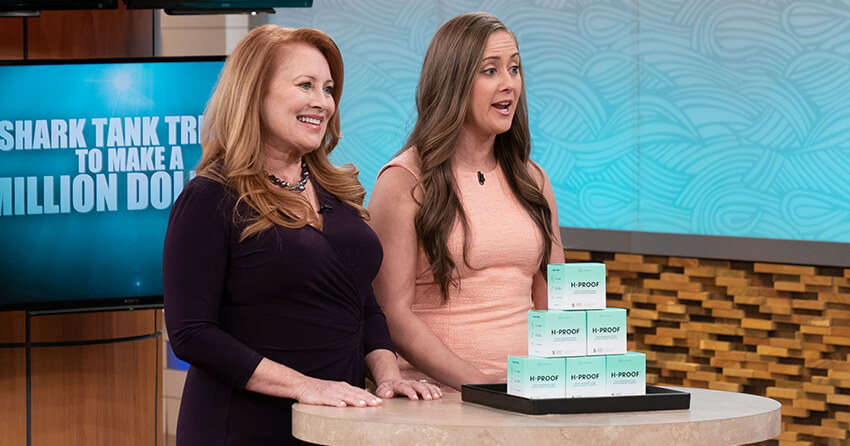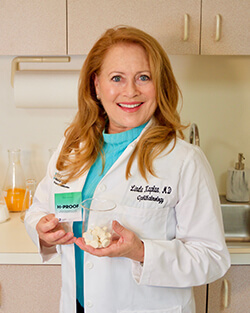Helping My Daughter Avoid Getting Hungover
Investigation into the biology of alcohol consumption leads to invention

Barbara Corcoran, of Shark Tank fame, once asked me on The Dr. Oz Show why in the world I would try to prevent my daughter’s hangovers through science instead of just advising her to refrain from drinking alcohol. It’s a fair question; maybe most parents would have reacted that way. But not me. As a Mensan, I’m intellectually curious and up for the challenge. If you present me with a problem, my immediate reaction is to try and solve it.
Because I am the first medical doctor to develop a patent-pending chewable tablet that helps your body metabolize alcohol, the Bulletin asked me to write about the science of “curing” hangovers.
First, there is a broad misconception that dehydration causes hangovers (the scientific term is veisalgia). Intuitively, we know this is false. Most of us have been dehydrated before. How we feel when we are dehydrated is different from how we feel when we’re hungover. Is waking up with a hangover the same feeling as playing sports or spending a day in the hot summer sun? Not really.
So, what’s happening in our bodies when we consume alcohol? There are a few processes at play, but let’s focus on the biggest. Alcohol is ingested through the digestive tract, and most of it lands in the liver, where it is mostly neutralized into inert acetate. In extrahepatic tissues, acetate is also converted into acetyl coenzyme A (Acetyl-CoA), water, and carbon dioxide. Acetyl-CoA is a molecule that participates in many biochemical reactions in protein, carbohydrate, and lipid metabolism. Its main function is to deliver the acetyl group to the citric acid cycle (Krebs cycle) to be oxidized for energy production.
As a physician, I am educated to know that our bodies naturally produce small amounts of alcohol every time we eat fruits and vegetables because they ferment in our gut. Most of us have enough enzymes to break down and neutralize the alcohol produced so we do not feel intoxicated. However, when we either manufacture or ingest more alcohol than we can neutralize, acetaldehyde, a toxic alcohol metabolite, spills out of the digestive tract into the general circulation and exacts an inflammatory effect throughout the body: veisalgia.
Analyzing the alcohol metabolic pathway made me think about what enzymes and molecules would be depleted as the liver worked harder to neutralize more alcohol. Needed components include alcohol dehydrogenase (ADH), aldehyde dehydrogenase (ALDH), cytochrome P450 (including but not limited to CYP2EI), catalase, glutathione, nicotinamide adenine dinucleotide phosphate (NADPH), and nicotinamide adenine dinucleotide (NAD+) to convert alcohol into acetate.
The key, it seemed, was to figure out how to replenish these enzymes and molecules, increasing the body’s alcohol-metabolizing capabilities.
When my daughter — a Columbia Law School graduate, I should mention — approached me with the question of preventing hangovers, she came in hand with a stack of global scientific research and anecdotes regarding how she and her millennial friends took prenatal vitamins before drinking. (None of them were pregnant, and some of them weren’t female.) This was exciting! Why was I stoked to hear that pregnancy vitamins helped ease veisalgia? Because they’re packed with B vitamins! Vitamin is a portmanteau for the words vital amine. Our bodies require vitamins to function, eight of which are in the B group. Of the B group vitamins, only niacin (B3) and biotin (B7) can be synthesized from certain substrates; the other six B vitamins (B1, B2, B5, B6, B9, B12) must be ingested.
Why was I stoked to hear that pregnancy vitamins helped ease veisalgia? Because they’re packed with B vitamins!
B1, or thiamine, is an essential nutrient used in every cell in the body. B2, riboflavin, assists in the metabolism of carbohydrates, proteins, and fats to make energy and act like an antioxidant. B3, niacin, is an enzyme precursor for NAD and NADP, which are crucial for alcohol metabolism. B5, pantothenic acid, is needed for CoA, which the liver uses to process toxins. B6, pyridoxine, is an essential nutrient that supports liver function and boosts energy. B9, folate, acts as a coenzyme, combating free radicals and is needed for DNA synthesis and the metabolism of amino acids. B12, methylcobalamin, helps make DNA.
Here, we had a great start. Our formula needed to include all six B vitamins that must be ingested because they are the building blocks that can replenish the depleted materials the body needs to metabolize alcohol. However, that wasn’t going to be enough. If, despite loading up on enzyme building blocks, some alcohol isn’t fully converted into acetate and becomes the toxin acetaldehyde, that acetaldehyde would be released throughout the body and cause veisalgia.
I turned my attention to the global research my daughter unearthed. Scientists have discovered that dihydromyricetin (DHM), N-Acetyl Cysteine (NAC), milk thistle (Sylimarin), and Taurine might help reduce cellular inflammation and repair damaged cells. Now we had the right combination of ingredients; we just had to figure out the therapeutically effective amounts of each one.
R&D isn’t complete without testing, and let me tell you, we put our formula to the test! For months, we drank and we tinkered, we drank and we tinkered. We drank and we tinkered with the levels of each individual ingredient until we were both happy with the results. The best part? After years of saying no to alcohol because even one glass of champagne would cause me next-day pain, I could say yes again! Everyone knows that as we age, our metabolism slows down — we can’t eat the way we did when we were in our 20s. The same is true for alcohol metabolism. In inventing a product for my millennial daughter, I actually created a product for myself. How’s that for a happy accident?
Once we had our formula nailed down, my daughter (now my co-founder and CEO) partnered with a U.S.-based manufacturer to turn it into a very tasty chewable tablet, H-PROOF was born, and we landed on The Dr. Oz Show!
I must note that the FDA has not reviewed my research or approved of our product. (There is currently no FDA approval process for nutraceuticals.) Our goal was to create something that would help my daughter wake up feeling better than she should after consuming alcohol, and that’s what we accomplished!

